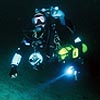Posted 10 June 2004 - 10:24 AM
Confusing indeed.
First off, physical size of the tank matters not to gas volume, or pressure.
Second, As far as I know, 'HP' and 'LP' are a bit of a misnomer, unless more definition is applied. The word 'Pressure' as it applies to compressed gas in metal cylinders means different things to different people, depending on the industry, the cylinder, the application, etc. In most American recreational scuba circles, HP mostly means a cylinder whose working pressure is above 3000 PSI. 'LP' More or less means anything under 3,000 PSI working pressure. I have heard the ubiquitous aluminum 80 termed both as an 'HP' and an 'LP' tank. I'm sure someone else can comment more on where the LP and HP designations came from, I just know they both hurt when dropped on my foot.
I think the issue of confusion besides labeling is tank volume, and tank pressure. Pressure (PSI) is not the same as volume (cubic feet). It's easy to tell how much gas (volume) you have when a cylinder is pressurized to its working, or 'rated' pressure. A scuba cylinder is most often referred to (in America) by the cubic feet of air it holds at it's rated pressure. I.E. a '95, a 120, an '80' a '72' etc.
If you stick 'LP' or 'HP' in front of those numbers, it more or less describes the general range of the maximum pressure the tank was designed (or deemed safe by one agency or another) to be filled. So, an 'HP'120 filled to it's rated pressure of 3,500 PSI holds about 120 cu, ft. of gas. an 'LP'95 holds about 95 cu. ft. of gas at it's rated pressure of 2,400 PSI. My father is known to hold close to 40 cu. ft. of gas after eating too much broccoli.
It can get tricky to guess how much gas is in a cylinder when it is only partially filled, unless you know the magic happy gas formula. Just like Walter & Andrew described, There's also a slightly more concise way to figure it. The goal is to be able to convert a known pressure (PSI) to a volume (cu. ft.) Also, to liberate some Mexican zebras from their oppressive regime, but that's another topic... Then you can easily figure how much gas you have.
As far as dive boats in California, no offense to any crew reading, but always talk to the captain to ascertain the capabilities of his boat. Walter's right, there is a lot of bad information out here, and I'd say the volume / pressure issue and HP / LP thing confuses many crew, and the people you get on the phone. They want to be helpful, so they give out wrong info instead of finding out for sure. ...Duuuude, like, MASSIVE pressure dude! Totally MASSIVE ! !
I use a so called HP80 for most of my recreational dives, and have been on (I think) every single dive boat from Ventura to San Diego in the last 5 years. Some with 'vintage' (read older) compressor systems are only able to fill to 2,500, but they are few and far between. A few only fill to 3K, but they are decreasing in numbers too. Most well run charters here are capable of handling 3500 PSI fills all day long. The HP thing has been around a while now, and most operators know they need to have the capability to serve this growing customer base. When in doubt, call and if you get anything other than a sure answer, ask for the owner dude, or captain dude.
There are a couple boats that do indeed pull the 'We don't have an adaptor for DIN valves' story. That's when I like to whip out my trusty adaptor (which any shop can get you for about $15-$20) and say, 'We don' need no stinking adaptor! I have one of my own!'. If you decide on a HP cylinder, an adaptor is a good extra to have in your save a dive kit. I also think that if a boat still doesn't handle what has become commonplace among divers, They don't need to have my business. There are LOTS of boats out here.
Jeff Schoonover
www.jetharness.com






















